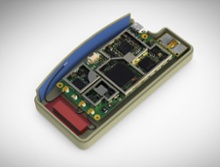
Industrial Designers: How We Integrate Antenna Design
Published on February 12, 2013

This week we'd like to welcome to our blog Rich Walters, LSR's Industrial Design Director. Rich has over 23 years of Industrial Design consulting experience, designing and leading cross functional design teams. His expertise covers a wide spectrum of product development, covering design research, interaction design, CAD, and prototyping. Rich has accumulated over 30 design patents and several utility and international patents. He holds a Bachelors of Science of Industrial Design from the University of Wisconsin-Stout, where he continues to serve on their Professional Advisory Board for the School of Art and Design.
The Roles of Industrial Designers
Industrial Designers serve two main roles in product development. In the first role they are innovators and advocates for the end user. They create value by discovering what problems need to be solved and learning what solutions best address them. They are focused on human needs and expectations. The better the user experience is with the product the better chance the product has for success. In the second role they are sculptors and tactical specialists, focusing on quality and getting the product manufactured well. Industrial Designers are often skilled at managing the details, making prototypes, researching materials, preparing CAD for production.
As products all around us become connected industrial designers are offering their unique skill sets to enhance wireless products. Wireless products have unique challenges because of the complex characteristics of antenna design. Having a design process and integrated team that supports these challenges will help products look and perform better. The following are several things to consider when using Industrial Design (ID) in wireless product development.
1. Industrial Designers can hide antennas. Antennas are often big, ugly, and usually need to be high and on top of the product or around the edges where the other internal components, end user and environment are less likely to interfere with antenna performance. Fortunately, Industrial Designers are great at making a large product look small and desirable. Often our customers come to us with off-the-shelf antennas that are inappropriate for where they need to be placed or what material they need to be near. Even stick-on antennas can be detuned by the type of plastic that they are attached to. More and more, antennas are being integrated right into the housings of products, essentially creating what is known as a Molded Interconnect Device (MID), a fancy word for injection molded plastic with integrated circuit traces. The MID can be an internal part or integrated into the exterior of the product. There are several ways to produce MIDs and all of them involve several processes, some requiring less tooling than others. To develop this type of antenna design or housing takes a team of Industrial Designer and Antenna Designer's who work side by side designing, simulating antenna patterns, building prototypes, and testing real physical prototypes in the chamber. The obvious outcome of integrated ID and antenna design is an inconspicuous and optimized antenna within the constraints of the ID.
2. Allow ID to inspire early. An integrated design team improves product development efficiency and quality. The ID industry has adopted a scientific approach to uncovering unmet needs and learning about the real use environment. This can lead to defining the physical goals earlier in the program and inspirations that can push the technology further by defining boundaries for the product that could affect antenna design later. If the antenna and PCB layout are designed without enough input or constraints from Industrial Designers opportunities will be missed to optimize the shape, performance, size, cost, assembly, and desirability of the product. When we are asked to fix an antenna issue there are generally three options to pursue with each having tradeoffs: Change the antenna only, change the circuitry, and changing the design of the product are the options to consider. Usually changing the ID is a last resort because of the schedule. Once again, make sure the Industrial Designers and Antenna Designers are communicating early.
3. Industrial Designers like freedom, but need boundaries too. Make sure the ID team knows any known limitations and general directions the antenna design may go. Make sure they understand the spatial and material challenges for your chosen antennas. Teach them what ground planes are, what happens when a human form is near the antenna and what havoc metallic paint can create. With enough information things will flow smoothly and they will come up with better options that satisfy all the stakeholders.
Summary
Remember that a talented and integrated ID and antenna team can make the product a success by addressing real needs and challenges. If boundaries and limitations are communicated and understood by all involved disciplines, unique and high performing products will result. The more challenging the ID and antenna assignment the greater the benefits of an integrated team that can use advanced manufacturing techniques to optimize the design.
 Laird Connectivity is now Ezurio
Laird Connectivity is now Ezurio